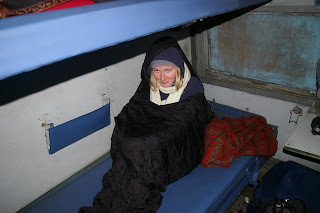Varanasi


.JPG)




As Mark Twain so succinctly described, this town is definitely old, and it bears the marks of it. There are old gali’s, old buildings that are pressed up against each other, dangerously vying for space and balance, even the people look old. Old not in the physical sense, but old in the sense of tradition, as if I could have came here 200 years ago and seen the people doing the same thing; painting their feet red, chewing gulps of pan, talking in an accent steeped in the days of yore. It’s a nice feeling. For me, this means that people are also a little bit friendlier. The occasional rickshaw driver will be overaggressive, and the occasional phulwallah (fruit-seller) will try to charge a little bit extra, but for the most part, no one has made me feel too uncomfortable (helped in some part I am sure by the cold stare I am able to mask my face with), and the rat race effect that has hit Delhi, Mussoorie, and other places I’ve been, has yet to bless Varanasi with its progressiveness. To be honest, for me, it is a relaxing place.
I like it. So far in India, besides my familial home in Punjab, I have not been able to let my head down, take it easy, and pretty much not worry as much as I have been able to in Varanasi. It almost seems like people are here for a different purpose. To the eye, it doesn’t seem like this bastion of Hindu culture is at all a bastion, but like a city that is still trying to be a village – a city that happens to be on the ganga, and a city where one can take a bath and milk some cows. But it does not have the typical glorifying attributes, such as Rome, Venice, New York, that I expect of a city that is proclaimed to be the center of a nations culture. I certainly have not heard anybody in Varanasi say that. It humbly makes no proclamation, but shows it’s depth upon a longer stay. On my third floor room in Rahul’s Guest House, the sounds of the tabla, sitar, and other instruments the names of which I am just learning waft out of my neighbors’ rooms. They are people who have come from all over, for the most part, Europe, and who are learning here in Varanasi. Nowhere have a seen a sign which says “Become a famous sitar player here!” nowhere have a seen culture turned into some marketable phenomenon. It’s nice, but perhaps a little bit sad for the people who are teaching – they could be making a lot more money.
Varanasi’s spirituality is somewhat like the fog that settles over the ganga and greets you in the morning. It is there, but in an unobtrusive way. It is not goal oriented, but meaning oriented, it is humble, a spirituality that is lived for the sake of living, not for the sake of where it will get you. It’s nice, it’s allowed me to relax, and allowed me to feel a little bit of a headache, something I didn’t realize I had until I got here. India, its fast autorickshas blaring at the impossible, its hustle and bustle to stay alive, and for many, to get rich, seems to take a few moments to breathe in Varanasi, and perhaps take a bath. It is a town that should be a village, and while this will not be noticeable in the main town, with all the rickshas and people plying the roads en masse, it is noticeable in its outskirts and in its quiet gulleys. It’s noticeable in Lanka, where many people seem to still, at least mentally, be living in the village. And, of course, it’s noticeable in the cows which crowd assi ghat, the non-inward non-outward I-don’t-know-where-you’re-looking-mr.-cow stares and unconcerned-over-salivating-mastication of which I always seem to get a kick out of as I make my way back home.
Though I have been here for over a week, these are still first impressions. I have yet to venture out of Assi ghat much more, and see what exactly Varanasi is made out of. There is something special here, perhaps it is spirituality. The best part for me is, while there seems to be something of Varanasi in the rest of the India which I have read and traveled in, there doesn’t seem to be something of the rest of India in Varanasi. It stands special, something different, and something that certainly attracts visitors here over and over again. Of course, the development in India is far behind, and yes, the city and the river are dirty, but looking past that, the ghats do not proclaim its virtue; the river does not advertise its history, its spirituality. Perhaps that is what is best about India, it is still a culture that is living its culture, the ganga cannot be packaged into a museum nor can it be scraped off and put in a glass bottle. It always renews itself. India has yet to place is culture in a plastic sterile bottle, and while I hope and pray for its quick development, while I hope people start treating the ganga better and taking better care of it, I hope that is never bottles up its culture.
.JPG)




